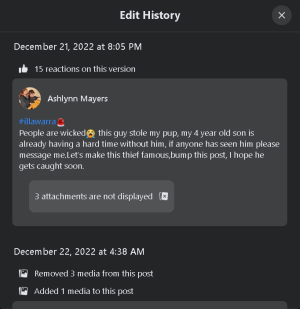Aussies warned against social media sob story scams
- Replies 3
Chances are you’ve come across at least one person’s cry for help on social media — be it a missing child, a dog hit by a truck, or something even more tragic and heartbreaking.
For all the problems in the world, most of us have a heart of gold and it’s only natural that when we hear tales of woe, natural disasters and personal crises, our empathy kicks in and wants to help as best we can.
But what if it turns out it was all a lie?
Unfortunately, recent reporting by the Australian Associated Press’s fact-checking initiative AAP Factcheck uncovered posts circulating in community-based Facebook groups that intend to trick people who only want to lend a helping hand.
These scams work by first having criminals post online claiming to be persons in distress who then ask for their stories to be spread — widening their pool of potential victims.
But as people begin to share it more and more, the post is then edited to include suspicious links which can give scammers access to people’s money or personal details.
An official of the Australian Competition and Consumer Commission confirmed that the said scheme aims to trick people out of their money or their sensitive information that could be used for identity theft.

‘When clicked on, these links can either be used to infect a person’s computer with malware or redirect a person to a website which is used to harvest account log-on details, passwords and personal information typically of accounts where banking and credit card information are stored,’ warned Brent Carey, CEO of online safety advocacy group Netsafe.
‘They are another example of attempts to trick a person into parting with personal or business details that a scammer can use to get access to a person’s identity or their business networks or systems in an attempt to get hold of ways to take money from a person.’
Another thing worth noting about these scams that prey on kindhearted Aussies is that the criminals behind them often time their activities during tragedies, such as when massive flooding hit Queensland, New South Wales, and Victoria last year.
Reports say the three states saw unusually high amounts of money linked to so-called fake charity scams.
Jacqueline Jayne, an advocate of security awareness from KnowBe4, said that such scams are widespread on social media — Facebook, in particular.
Sadly, according to her, they’re also successful in many cases.
‘Unfortunately, the reason that these type of scams are so successful … it’s because we’re kind,’ she said. ‘We’re humans and we want to help.’
‘I’m a bit cautious of things that pop up on social media sites that really pull on your heartstrings, to be honest, because we are helpful people … and we lean towards wanting to believe that people are telling us the truth.

The latest data available from Scam Watch reveals that Australians lost $526.3 million to scammers in 2022.
Of this amount, $416,020 was lost in 748 incidents of fake charity scams.
‘So if you see something and think, “I would really like to help this person”, spend some time doing research and due diligence to find out if it’s real, because people can copy other people’s legitimate stuff so it looks real,’ Jayne added.
So how can you tell when a plea for help is genuine, or when it’s a scam?
Verifying requests for help on social media can be a challenge, as scammers are constantly adapting their tactics to deceive their victims. However, there are a number of strategies that can be used to help people distinguish between legitimate requests for help and attempts to scam them.
The first step is to take a look at the profile of the person who posted the request.
Check to see how many friends they have, look through their photos, and read through any prior posts they’ve made. It won’t exactly translate to their appeal being true, but at least it can offer a clue if the poster has a real social media presence.
One massive red flag to watch out for is if the account appears to have been made shortly before posting a call for assistance.

Additionally, searching the post’s keywords in the social media platform’s search bar can help to uncover if the post has been made before, as this could be a sign of a scam.
And for companies or other groups soliciting for help, it would be wise to check if they’re listed at the Australian Charities and Not-for-profits Commission.
Overall, the best way to protect yourself from social media scams is to take the time to investigate any requests for help. While most people who post requests have good intentions, verifying them can save you from falling prey to a scam.
Remember, be extra vigilant and do your research before you contribute to a social media plea. Especially when it comes to your hard-earned money!
You can also keep posted on the latest ways these nasty criminals try to get a hold of your money at our ScamWatch forum.
If you have time, you can check out how more than a hundred people were tricked into attending a non-existent New Year’s Eve party or how scammers are setting their sights on online sellers.
Have you come across similar sketchy posts of people asking for help? What did you do?
Tell us in the comments section below!
For all the problems in the world, most of us have a heart of gold and it’s only natural that when we hear tales of woe, natural disasters and personal crises, our empathy kicks in and wants to help as best we can.
But what if it turns out it was all a lie?
Unfortunately, recent reporting by the Australian Associated Press’s fact-checking initiative AAP Factcheck uncovered posts circulating in community-based Facebook groups that intend to trick people who only want to lend a helping hand.
These scams work by first having criminals post online claiming to be persons in distress who then ask for their stories to be spread — widening their pool of potential victims.
But as people begin to share it more and more, the post is then edited to include suspicious links which can give scammers access to people’s money or personal details.
An official of the Australian Competition and Consumer Commission confirmed that the said scheme aims to trick people out of their money or their sensitive information that could be used for identity theft.

As harsh as it sounds, don’t be too quick to lend a helping hand to people online. Image Credit: Pexels/Mihail Nilov
‘When clicked on, these links can either be used to infect a person’s computer with malware or redirect a person to a website which is used to harvest account log-on details, passwords and personal information typically of accounts where banking and credit card information are stored,’ warned Brent Carey, CEO of online safety advocacy group Netsafe.
‘They are another example of attempts to trick a person into parting with personal or business details that a scammer can use to get access to a person’s identity or their business networks or systems in an attempt to get hold of ways to take money from a person.’
Another thing worth noting about these scams that prey on kindhearted Aussies is that the criminals behind them often time their activities during tragedies, such as when massive flooding hit Queensland, New South Wales, and Victoria last year.
Reports say the three states saw unusually high amounts of money linked to so-called fake charity scams.
Jacqueline Jayne, an advocate of security awareness from KnowBe4, said that such scams are widespread on social media — Facebook, in particular.
Sadly, according to her, they’re also successful in many cases.
‘Unfortunately, the reason that these type of scams are so successful … it’s because we’re kind,’ she said. ‘We’re humans and we want to help.’
‘I’m a bit cautious of things that pop up on social media sites that really pull on your heartstrings, to be honest, because we are helpful people … and we lean towards wanting to believe that people are telling us the truth.

An example of an account flagged by AAP Factcheck changing their post to include one with a suspicious link. Screengrab Credit: Facebook
The latest data available from Scam Watch reveals that Australians lost $526.3 million to scammers in 2022.
Of this amount, $416,020 was lost in 748 incidents of fake charity scams.
‘So if you see something and think, “I would really like to help this person”, spend some time doing research and due diligence to find out if it’s real, because people can copy other people’s legitimate stuff so it looks real,’ Jayne added.
So how can you tell when a plea for help is genuine, or when it’s a scam?
Verifying requests for help on social media can be a challenge, as scammers are constantly adapting their tactics to deceive their victims. However, there are a number of strategies that can be used to help people distinguish between legitimate requests for help and attempts to scam them.
The first step is to take a look at the profile of the person who posted the request.
Check to see how many friends they have, look through their photos, and read through any prior posts they’ve made. It won’t exactly translate to their appeal being true, but at least it can offer a clue if the poster has a real social media presence.
One massive red flag to watch out for is if the account appears to have been made shortly before posting a call for assistance.

A look at the post history of one account AAP Factcheck flagged reveals their earlier claim of someone stealing their pet. Screengrab Credit: Facebook
Additionally, searching the post’s keywords in the social media platform’s search bar can help to uncover if the post has been made before, as this could be a sign of a scam.
And for companies or other groups soliciting for help, it would be wise to check if they’re listed at the Australian Charities and Not-for-profits Commission.
Overall, the best way to protect yourself from social media scams is to take the time to investigate any requests for help. While most people who post requests have good intentions, verifying them can save you from falling prey to a scam.
Remember, be extra vigilant and do your research before you contribute to a social media plea. Especially when it comes to your hard-earned money!
You can also keep posted on the latest ways these nasty criminals try to get a hold of your money at our ScamWatch forum.
If you have time, you can check out how more than a hundred people were tricked into attending a non-existent New Year’s Eve party or how scammers are setting their sights on online sellers.
Have you come across similar sketchy posts of people asking for help? What did you do?
Tell us in the comments section below!








